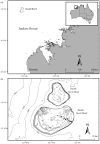Symbiodinium genotypic and environmental controls on lipids in reef building corals
- PMID: 21637826
- PMCID: PMC3102723
- DOI: 10.1371/journal.pone.0020434
Symbiodinium genotypic and environmental controls on lipids in reef building corals
Abstract
Background: Lipids in reef building corals can be divided into two classes; non-polar storage lipids, e.g. wax esters and triglycerides, and polar structural lipids, e.g. phospholipids and cholesterol. Differences among algal endosymbiont types are known to have important influences on processes including growth and the photobiology of scleractinian corals yet very little is known about the role of symbiont types on lipid energy reserves.
Methodology/principal findings: The ratio of storage lipid and structural lipid fractions of Scott Reef corals were determined by thin layer chromatography. The lipid fraction ratio varied with depth and depended on symbiont type harboured by two corals (Seriatopora hystrix and Pachyseris speciosa). S. hystrix colonies associated with Symbiodinium C1 or C1/C# at deep depths (>23 m) had lower lipid fraction ratios (i.e. approximately equal parts of storage and structural lipids) than those with Symbiodinium D1 in shallow depths (<23 m), which had higher lipid fraction ratios (i.e. approximately double amounts of storage relative to structural lipid). Further, there was a non-linear relationship between the lipid fraction ratio and depth for S. hystrix with a modal peak at ∼23 m coinciding with the same depth as the shift from clade D to C types. In contrast, the proportional relationship between the lipid fraction ratio and depth for P. speciosa, which exhibited high specificity for Symbiodinium C3 like across the depth gradient, was indicative of greater amounts of storage lipids contained in the deep colonies.
Conclusions/significance: This study has demonstrated that Symbiodinium exert significant controls over the quality of coral energy reserves over a large-scale depth gradient. We conclude that the competitive advantages and metabolic costs that arise from flexible associations with divergent symbiont types are offset by energetic trade-offs for the coral host.
Conflict of interest statement
Figures




References
-
- Muscatine L. Productivity of zooxanthellae. In: Falkowski PG, editor. Primary Productivity in the Sea. New York: Plenum Press; 1980. pp. 381–402.
-
- Porter JW. Zooplankton feeding by the Caribbean reef-building coral Montastrea cavernosa; In: Cameron AM, Campbell BM, Cribb AB, Endean R, Jell JS, et al., editors. Brisbane (Australia): The Great Barrier Reef Committee; 1974.
-
- Tomascik T, Sander F. Effects of eutrophication on reef-building corals. 1. Growth rate of the reef-building coral Montastrea annularis. Marine Biology. 1985;87:143–155.
-
- Anthony KRN. Coral suspension feeding on fine particulate matter. Journal of Experimental Marine Biology and Ecology. 1999;232:85–106.
-
- Anthony KRN. Enhanced particle-feeding capacity of corals on turbid reefs (Great Barrier Reef, Australia). Coral Reefs. 2000;19:59–67.
Publication types
MeSH terms
Substances
LinkOut - more resources
Full Text Sources
Miscellaneous

